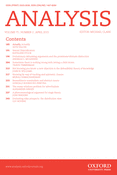-
Views
-
Cite
Cite
Michelle Montague, The Objects of Thought By TIM CRANE, Analysis, Volume 75, Issue 2, April 2015, Pages 335–339, https://doi.org/10.1093/analys/anu161
Close - Share Icon Share
Extract
The main aim of Tim Crane’s book The Objects of Thought is to give an account of non-existent objects. We need such an account, according to Crane, because ‘we have no adequate understanding of the mind unless we also have an understanding of the non-existent’ (4). The possibility of our thinking about and saying true things about non-existent objects has a rich history (see e.g. Grossman 1974, Meinong 1904, Parsons 1980, Routley 1980, Tichy 1988, and Zalta 1983). But whereas these philosophers have been led into the darkest depths of metaphysics, Crane’s solution is refreshingly elegant and simple: thinking and saying true things about non-existent objects requires nothing more than our thoughts about the non-existent – there’s no need for any hair-raising metaphysics.
This solution involves several theses, including the following. (1) Because quantification over non-existents is intelligible, ontological commitment should not be thought of in terms of quantification. (2) There are two kinds of properties, ‘pleonastic’ and ‘substantial’ or ‘existence-entailing’, and non-existent objects only (really) have the pleonastic kind. (3) A general theory of intentionality must advert to and distinguish clearly between intentional modes, intentional content, and intentional objects. (4) Relational conceptions of intentionality are phenomenologically inadequate. (5) Thinking about particular objects does not require a notion of acquaintance understood as an epistemological or semantical notion; rather such thoughts should be accounted for in terms of mental files construed as a psychological notion.




